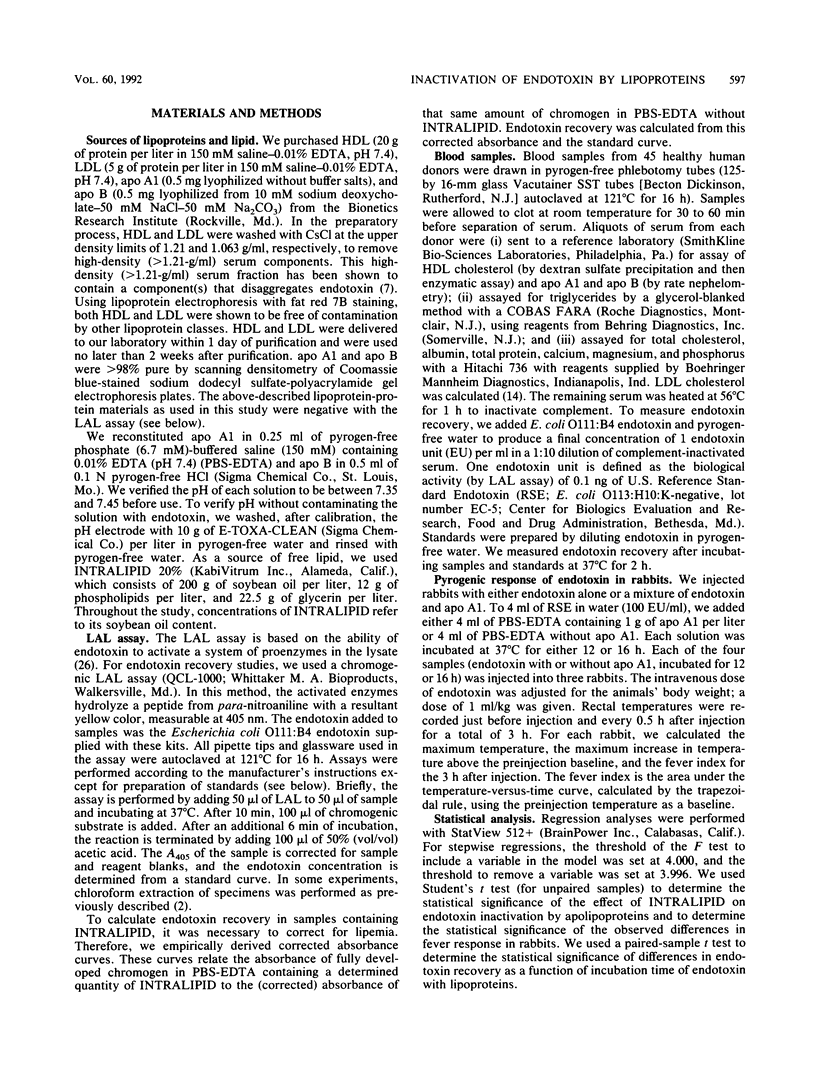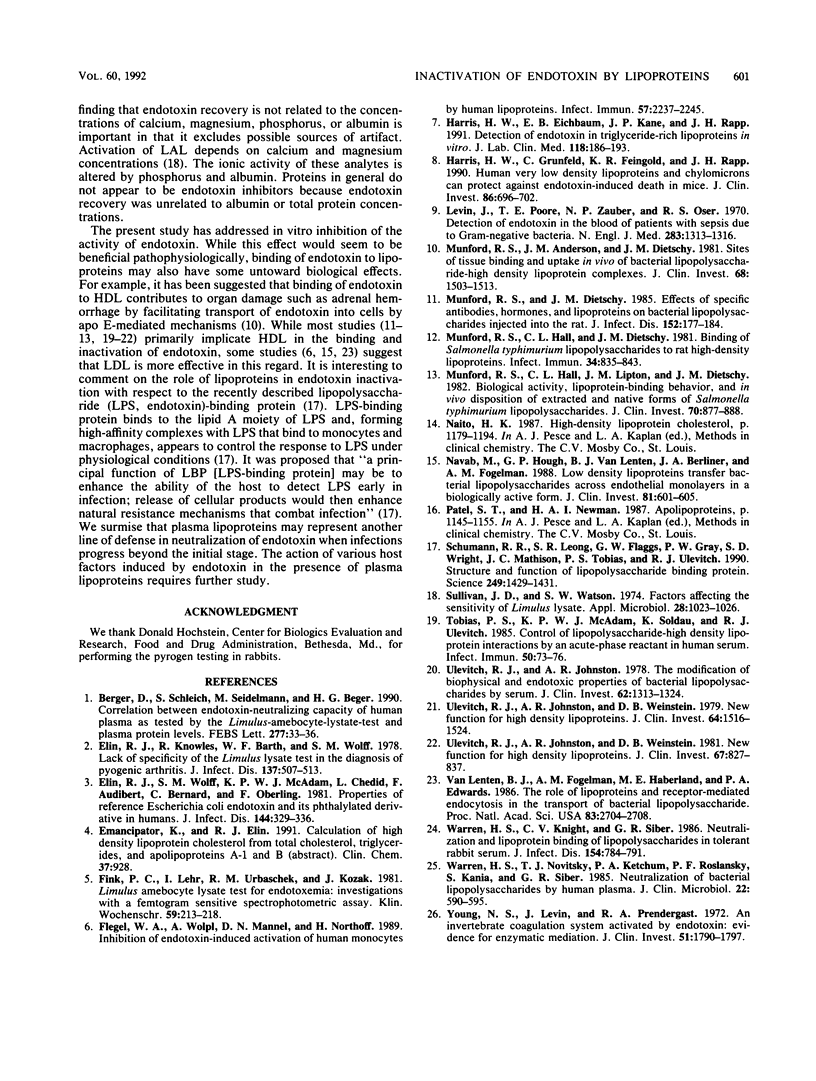Abstract
A chromogenic Limulus amebocyte lysate assay was used to measure the recovery of 1 endotoxin unit of endotoxin per ml. Purified human high-density lipoprotein, low-density lipoprotein, and apolipoprotein A1 (apo A1) at a maximum concentration of 1 g of protein per liter reduced the recovery to less than 40% of baseline in a both dose- and time-dependent manner and in the absence of other serum components. Furthermore, the lapine fever response to a dose of 1 ml of 5-ng/ml endotoxin per kg was reduced by greater than 0.5 degrees C (P less than 0.005) when the solution was preincubated in vitro with 0.5 g of apo A1 per liter. By the Limulus test, a maximum concentration of 0.01 g of apolipoprotein B (apo B) per liter (which contained deoxycholate, a known endotoxin-disaggregating agent) reduced recovery to 0% in a dose- but not time-dependent manner. In heat-inactivated (56 degrees C, 1 h) normal human serum, high-density lipoprotein cholesterol (P less than 0.005) and apo A1 (P less than 0.05) correlated inversely with endotoxin recovery, but, paradoxically, apo B correlated directly with endotoxin recovery (P less than 0.05), while low-density lipoprotein cholesterol showed no significant correlation. INTRALIPID alone had no effect on endotoxin recovery. Addition of a maximum of 10 g of INTRALIPID per liter to 0.0042 g of apo B per liter increased endotoxin recovery from approximately 30 to 80% (P less than 0.001), but addition of INTRALIPID to 0.25 g of apo A1 per liter decreased recovery from approximately 30 to 20% (P less than 0.001). We conclude that (i) lipoproteins are endotoxin inactivators; (ii) this ability of lipoproteins may be modulated by their lipid component (lipid-endotoxin interaction); (iii) apo A1 is capable of directly inactivating endotoxin (protein-endotoxin interaction).
Full text
PDF





Selected References
These references are in PubMed. This may not be the complete list of references from this article.
- Berger D., Schleich S., Seidelmann M., Beger H. G. Correlation between endotoxin-neutralizing capacity of human plasma as tested by the limulus-amebocyte-lysate-test and plasma protein levels. FEBS Lett. 1990 Dec 17;277(1-2):33–36. doi: 10.1016/0014-5793(90)80803-q. [DOI] [PubMed] [Google Scholar]
- Elin R. J., Knowles R., Barth W. F., Wolff S. M. Lack of specificity of the limulus lysate test in the diagnosis of pyogenic arthritis. J Infect Dis. 1978 May;137(5):507–513. doi: 10.1093/infdis/137.5.507. [DOI] [PubMed] [Google Scholar]
- Elin R. J., Wolff S. M., McAdam K. P., Chedid L., Audibert F., Bernard C., Oberling F. Properties of reference Escherichia coli endotoxin and its phthalylated derivative in humans. J Infect Dis. 1981 Oct;144(4):329–336. doi: 10.1093/infdis/144.4.329. [DOI] [PubMed] [Google Scholar]
- Fink P. C., Lehr L., Urbaschek R. M., Kozak J. Limulus amebocyte lysate test for endotoxemia: investigations with a femtogram sensitive spectrophotometric assay. Klin Wochenschr. 1981 Mar 2;59(5):213–218. doi: 10.1007/BF01476578. [DOI] [PubMed] [Google Scholar]
- Flegel W. A., Wölpl A., Männel D. N., Northoff H. Inhibition of endotoxin-induced activation of human monocytes by human lipoproteins. Infect Immun. 1989 Jul;57(7):2237–2245. doi: 10.1128/iai.57.7.2237-2245.1989. [DOI] [PMC free article] [PubMed] [Google Scholar]
- Harris H. W., Eichbaum E. B., Kane J. P., Rapp J. H. Detection of endotoxin in triglyceride-rich lipoproteins in vitro. J Lab Clin Med. 1991 Aug;118(2):186–193. [PubMed] [Google Scholar]
- Harris H. W., Grunfeld C., Feingold K. R., Rapp J. H. Human very low density lipoproteins and chylomicrons can protect against endotoxin-induced death in mice. J Clin Invest. 1990 Sep;86(3):696–702. doi: 10.1172/JCI114765. [DOI] [PMC free article] [PubMed] [Google Scholar]
- Levin J., Poore T. E., Zauber N. P., Oser R. S. Detection of endotoxin in the blood of patients with sepsis due to gran-negative bacteria. N Engl J Med. 1970 Dec 10;283(24):1313–1316. doi: 10.1056/NEJM197012102832404. [DOI] [PubMed] [Google Scholar]
- Munford R. S., Andersen J. M., Dietschy J. M. Sites of tissue binding and uptake in vivo of bacterial lipopolysaccharide-high density lipoprotein complexes: studies in the rat and squirrel monkey. J Clin Invest. 1981 Dec;68(6):1503–1513. doi: 10.1172/JCI110404. [DOI] [PMC free article] [PubMed] [Google Scholar]
- Munford R. S., Dietschy J. M. Effects of specific antibodies, hormones, and lipoproteins on bacterial lipopolysaccharides injected into the rat. J Infect Dis. 1985 Jul;152(1):177–184. doi: 10.1093/infdis/152.1.177. [DOI] [PubMed] [Google Scholar]
- Munford R. S., Hall C. L., Dietschy J. M. Binding of Salmonella typhimurium lipopolysaccharides to rat high-density lipoproteins. Infect Immun. 1981 Dec;34(3):835–843. doi: 10.1128/iai.34.3.835-843.1981. [DOI] [PMC free article] [PubMed] [Google Scholar]
- Munford R. S., Hall C. L., Lipton J. M., Dietschy J. M. Biological activity, lipoprotein-binding behavior, and in vivo disposition of extracted and native forms of Salmonella typhimurium lipopolysaccharides. J Clin Invest. 1982 Oct;70(4):877–888. doi: 10.1172/JCI110684. [DOI] [PMC free article] [PubMed] [Google Scholar]
- Schumann R. R., Leong S. R., Flaggs G. W., Gray P. W., Wright S. D., Mathison J. C., Tobias P. S., Ulevitch R. J. Structure and function of lipopolysaccharide binding protein. Science. 1990 Sep 21;249(4975):1429–1431. doi: 10.1126/science.2402637. [DOI] [PubMed] [Google Scholar]
- Sullivan J. D., Jr, Watson S. W. Factors affecting the sensitivity of Limulus lysate. Appl Microbiol. 1974 Dec;28(6):1023–1026. doi: 10.1128/am.28.6.1023-1026.1974. [DOI] [PMC free article] [PubMed] [Google Scholar]
- Tobias P. S., McAdam K. P., Soldau K., Ulevitch R. J. Control of lipopolysaccharide-high-density lipoprotein interactions by an acute-phase reactant in human serum. Infect Immun. 1985 Oct;50(1):73–76. doi: 10.1128/iai.50.1.73-76.1985. [DOI] [PMC free article] [PubMed] [Google Scholar]
- Ulevitch R. J., Johnston A. R. The modification of biophysical and endotoxic properties of bacterial lipopolysaccharides by serum. J Clin Invest. 1978 Dec;62(6):1313–1324. doi: 10.1172/JCI109252. [DOI] [PMC free article] [PubMed] [Google Scholar]
- Ulevitch R. J., Johnston A. R., Weinstein D. B. New function for high density lipoproteins. Isolation and characterization of a bacterial lipopolysaccharide-high density lipoprotein complex formed in rabbit plasma. J Clin Invest. 1981 Mar;67(3):827–837. doi: 10.1172/JCI110100. [DOI] [PMC free article] [PubMed] [Google Scholar]
- Ulevitch R. J., Johnston A. R., Weinstein D. B. New function for high density lipoproteins. Their participation in intravascular reactions of bacterial lipopolysaccharides. J Clin Invest. 1979 Nov;64(5):1516–1524. doi: 10.1172/JCI109610. [DOI] [PMC free article] [PubMed] [Google Scholar]
- Van Lenten B. J., Fogelman A. M., Haberland M. E., Edwards P. A. The role of lipoproteins and receptor-mediated endocytosis in the transport of bacterial lipopolysaccharide. Proc Natl Acad Sci U S A. 1986 Apr;83(8):2704–2708. doi: 10.1073/pnas.83.8.2704. [DOI] [PMC free article] [PubMed] [Google Scholar]
- Warren H. S., Knights C. V., Siber G. R. Neutralization and lipoprotein binding of lipopolysaccharides in tolerant rabbit serum. J Infect Dis. 1986 Nov;154(5):784–791. doi: 10.1093/infdis/154.5.784. [DOI] [PubMed] [Google Scholar]
- Warren H. S., Novitsky T. J., Ketchum P. A., Roslansky P. F., Kania S., Siber G. R. Neutralization of bacterial lipopolysaccharides by human plasma. J Clin Microbiol. 1985 Oct;22(4):590–595. doi: 10.1128/jcm.22.4.590-595.1985. [DOI] [PMC free article] [PubMed] [Google Scholar]
- Young N. S., Levin J., Prendergast R. A. An invertebrate coagulation system activated by endotoxin: evidence for enzymatic mediation. J Clin Invest. 1972 Jul;51(7):1790–1797. doi: 10.1172/JCI106980. [DOI] [PMC free article] [PubMed] [Google Scholar]


